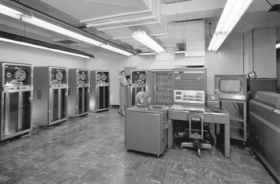



IBM's first magnetic-tape data storage devices, introduced in 1952, use what is now generally known as 7-track tape. The magnetic tape is 1⁄2 inch (13 mm) wide, and there are six data tracks plus one parity track for a total of seven parallel tracks that span the length of the tape. Data is stored as six-bit characters, with each bit of the character and the additional parity bit stored in a different track.
These tape drives were mechanically sophisticated floor-standing drives that used vacuum columns to buffer long U-shaped loops of tape. Between active control of powerful reel motors and vacuum control of these U-shaped tape loops, extremely rapid start and stop of the tape at the tape-to-head interface could be achieved. When active, the two tape reels thus fed tape into or pulled tape out of the vacuum columns, intermittently spinning in rapid, unsynchronized bursts resulting in visually striking action. Stock shots of such vacuum-column tape drives in motion were widely used to represent "the computer" in films and television.
